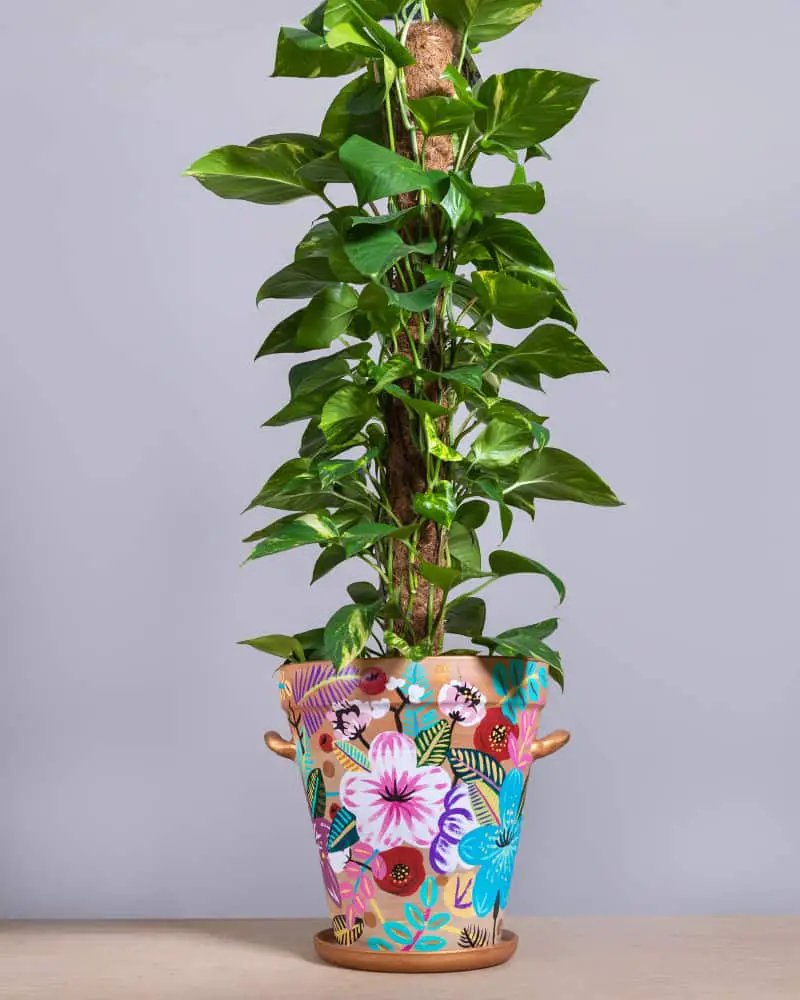How To train Pothos to Climb: Useful Beginner’s Guide
Pothos (also called Devil Ivy or Philodendron) is a great indoor vine that gives your space many visual hits. These plants are perfect in low light, making them great indoor plants. Pothos is happy growing on a windowsill or other spot with indirect light. But if you want to train it to climb up a wall or along another surface, you’ll need to know how to train pothos to climb.
Read on for everything you need to know about training pothos vines and helping them grow up instead of out.
What is pothos?
Golden Pothos (Epipremnum aureum) is usually grown in low-humidity tropical regions. They are climbing plants that can be cultivated indoors and outdoors.

A pothos is a plant that’s not just one thing but a name for any of 20 species of tropical vines in the family Araceae, which are sometimes used alone or combined with other plants to create that tropical feel. These vines are grown for their large, arrow-shaped leaves that are often dark green or silver and can reach up to 10 feet in length. However, many cultivars only grow to 2 or 3 feet in height.
It is an easy plant to care for and can thrive in various conditions. It prefers moist soil but will do well in indirect sunlight or total sun exposure. The Pothos aerial root system enables it to climb up the vertical surfaces and catch the sunlight, producing energy for its growth process. Water regularly when growing indoors. Allow them to dry out slightly between waterings before watering again.
The most crucial thing about growing pothos is to make sure not to overwater during winter as it can cause root rot. Try to keep its pot size no smaller than four inches because it likes that much space for climbing higher up on your wall or ceiling! Avoid overwatering this plant at least once every two weeks by watering it only when the top 50% of the soil becomes dry.
- LIVE INDOOR PLANT: Bring home a gorgeous Golden Pothos plant that is...
- ELEVATE MOOD & WELLBEING: Plants make us happy. They give us life, fresh...
- FRESH FROM FARM: Every plant is packed with care and direct from our farm...
How to train pothos to climb?
1. Find a healthy pothos plant that you want to grow.
2. Cut the lower leaves off the pothos plant, leaving 1-3 inches of stem attached at each end. You will need these stems later on for growing pothos vines.
3. Plant the trimmed pothos in a pot with good drainage and soil made primarily of organic matter (fertilize once every two weeks). Ensure plenty of light exposure for your plants; they like direct sunlight but can do well in shaded areas, provided adequate water is available.
4. Allow the roots to grow out, and then use a sharp knife to trim them down to about an inch long (or even shorter, depending on your plant). Do not cut into the stem! You will need the branches for growing Pothos vines later on.
5. Once roots have grown somewhat deep in the soil, begin training pothos vines up nearby objects using long stems from established plants as anchors (hang over edges of pots or windows, attach between tree branches above ground level). Repeat until you are happy with how high your pothos plant is growing.
6. Water your pothos plant regularly – They do not need to be constantly wet but like regular watering. Water again when it is slightly dry..
7. Enjoy your beautiful climbing pothos!
There are many different ways you can do a pothos climb. Consider your plant’s size and weight before deciding on one of these alternatives. It may also be trained to climb using “bonding”. This process involves attaching the vine directly to a surface, usually with a fishing line or string. The tension on the line will cause the pothos vine to grow upwards and attach itself firmly to whatever was used as an anchor point. Once bound, you can begin training it by pulling on the vines until they reach their desired height.
Materials that help pothos climb.
With many different ways to train pothos to climb, it’s crucial to have suitable materials. Here are a few methods you can use for them to climb.
Moss pole
- Stylish Design: Enhance your home decor with these 2 brown coir totem...
- Aids Plant Growth: These moss pole plant supports help creeping plants with...
- Easy to Use: Simply place the stakes next to your climbing plants and train...

Using a moss pole is one of the most popular methods to make pothos look beautiful and exciting. You can use this technique with other plants too! Make sure that the moss on the pole is not wet before you attach the plant. This will cause it to lose its grip. The string can also be used to help your plants reach great heights. Ensure the soil isn’t wet before putting the plant on the pole. Otherwise, it’ll lose its grip.
Step 1: Cut a moss pole at least 18 inches in length. The ideal pole height will be determined by the size of r plants and the width of your pot or window.
Step 2: Insert one end of the moss pole into the soil up to 6 inches deep, ensuring it is firmly anchored. Position the other ends over the edge of the container so that it hangs down vertically, like a curtain pole style.
Bamboo pole
- Each package contains 20pcs bamboo stakes, about 1.33' /16 inch height....
- Mini size bamboo stakes is very suitable for potted plants, indoor plants,...
- Made of bamboo, easy to cut and drill, less expensive than wood or metal,...
You can also create a vertical climbing frame for plants using bamboo poles. Make sure the bar is at least 18 inches long, has a few bends, and is sturdy. Simply dig a hole large enough for the pole, and insert it into the ground so that both ends are 6 to 12 inches below ground level. Next, secure one end of the bamboo pole to a post or tree using cable ties or wire. Make sure you position the other end over an open space where your plant can grow towards it. This method is perfect for plants that like to climb, such as pothos.
Trellis
- Ideal Garden Trellis:Height 6.3 feet(75.6 inches), perfect size to work as...
- Friendly Service:Worry-free 12 months warranty.If any parts missing or...
- Stunning & Decorative: The vertical tower obelisk with aesthetic design...
Trellises are great for anchoring pothos plants. To train your plant to climb the trellis, dig a hole twice the size of your plant and set the trellis in it. Secure the trellis to a post or tree using cable ties. Make sure the trellis rests on level soil and has enough space beneath it for your plant to grow.
However, be careful not to let the trellis get wet, or your plant will grow roots that may be difficult to remove.
String
You can also train your pothos with string. Simply tie one end of the rope around a post or tree and the other around the plant’s stem. The knot should be at least 6 inches from the base of the plant, particularly Pothos plants.
Metal pole
Another way to train your pothos is to use a metal pole. Ensure the pole is 18 inches long and has a few bends. Insert the metal pole into the ground so that one end is 6 to 12 inches below ground level. Next, secure one end of the metal pole using cable ties or wire. Make sure you position the other end over an open space where your plant can grow towards it.
U-shaped hoop trellis
- Package includes 20 pack bamboo trellis, height: 16 inch, upside width: 7.9...
- Our premium bamboo trellis are all handmade, very strong and flexible, heat...
- Provide sturdy support for your potted climbing plants, such as wisteria,...
The u-shaped hoop trellis is the easiest to use. You can purchase one for a few dollars at your nearest hardware store or garden center and insert it into your soil in the afternoon on a day you won’t be home,
Indoor Wall Training
If you have an indoor wall that your pothos can cling to, it’s a great way to train it. Simply purchase strong wire anchors and drill 1/8-inch holes at intervals of 4 or 5 feet along the top of the wall, spacing them about 6 inches apart. Thread one end of the anchor through each hole and tighten the screw until snug. Repeat on the opposite side of the wall. Then hang your pothos from the anchors, ensuring it’s balanced so that the stem is perpendicular to the ground.
Windows grill
Another way to train them is to attach them to a window grill. I like it the most by placing my pothos by the window and pulling them up with twine. It gives my window more greenery and makes me feel like I’m part of the natural world. And it also enhances my windows’ look.
Once your pothos is trained, it will be much easier to care for. Be sure to water regularly, fertilize with a potent fertilizer once a month, and remove any pests that may attack the plant.
Using the above method, you can understand How To make Pothos climb. Following the above recommendation, you can also grow plants such as philodendron and anthurium.

Questions:
When To Start Training Your Pothos to Climb?
The best time to start training your pothos to climb is when it’s young and in a small pot. Once the plant has grown more significant, you can begin Training It To Climb by attaching it to a hoop or frame. Remember to give your pothos plenty of water and fertilizer, and keep an eye on them to ensure it’s getting the support it needs.
Does Pothos Prefer Hang Or Climbing?
Pothos plants prefer hanging or climbing. It’s essential to provide a good balance of plant nutrients while training your plants to optimally develop their climbing and hanging skills. You can be trained to grow in various shapes and sizes when grown in a container.
Do Pothos Damage Your Walls?
While pothos plants tend to multiply and can cause damage to walls if not supervised, most damage is usually caused by gardeners pulling out the plant by its root or top instead of training it properly.
How Long Does It Take Your Pothos To Climb?
It depends on the size of the pothos and where you have placed them. It will usually take your pothos about 6 months to get fully scaled. If you know how to train pothos to climb and give them the right water and fertilizer, you will have a rewarding plant in no time.
Tips For Pushing Your Pothos To Climb Faster
Begin by wrapping the plant in a soft cloth or pillowcase. This will help to muffle the noise made as the pothos climbs and absorb some of its energy, making it easier for you to control.
Provide plenty of dense planting soil at each potting location, so your pothos has something solid to cling onto as it grows upward.
Conclusion
Now that you know how to train pothos to climb, it is time to be the gardener of your dreams. Rejoice in your newfound skill and start the pruning process and watering schedule. You’ll be amazed by how fast they begin to create a pleasant green curtain all around you!
Reference :- Pothos care











